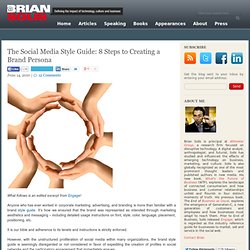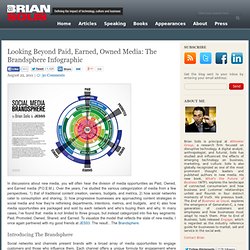

The Social Media Style Guide: 8 Steps to Creating a Brand Persona Brian Solis. InShare26 What follows is an edited excerpt from Engage!

Anyone who has ever worked in corporate marketing, advertising, and branding is more than familiar with a brand style guide. It’s how we ensured that the brand was represented as intended through marketing aesthetics and messaging – including detailed usage instructions on font, style, color, language, placement, positioning, etc. It is our bible and adherence to its tenets and instructions is strictly enforced. However, with the unstructured proliferation of social media within many organizations, the brand style guide is seemingly disregarded or not considered in favor of expediting the creation of profiles in social networks and the participatory engagement that immediately ensues. Everything the brand was intended to represent is no less important simply because new tools and services make it easier for anyone within the company to reach and connect with markets. The goal of a social media style guide is to establish: 1. 2. 3. 4.
New Infographic: The Brandsphere by Brian Solis and JESS3 Brian Solis. InShare698 In discussions about new media, you will often hear the division of media opportunities as Paid, Owned, and Earned media (P.O.E.M.).

Over the years, I’ve studied the various categorization of media from a few perspectives, 1) that of traditional content creation, owners, budgets, and metrics, 2) how social networks cater to consumption and sharing, 3) how progressive businesses are approaching content strategies in social media and how they’re rethinking departments, intentions, metrics, and budgets, and 4) also how media opportunities are packaged and sold by each network and who’s buying them and why.
In many cases, I’ve found that media is not limited to three groups, but instead categorized into five key segments: Paid, Promoted, Owned, Shared, and Earned. To visualize the model that reflects the state of new media, I once again partnered with my good friends at JESS3. The result…The Brandsphere. 1. 2. 3. 4: Promoted: in-stream or social paid promotions vehicles (e.g. 5.
Looking to the Frontiers of Social Business « Dachis Group Collaboratory. Recently I’ve been taking a close look at what is coming next in social business.

While social media has grown to become standard in just about every company’s business portfolio, it’s just as clear that things are not standing still. The business blogs and customer forums of a half decade ago are still here (and still important), but the larger strategic discussion has moved well beyond them to more transformative thinking, with approaches to match. This week I’ve spent a lot of time looking at one of the next frontiers of social business, the intersection of application software and social networks.
As I examined on ebizQ, the next app you use is increasingly likely to be inside a consumer social network such as Facebook or LinkedIn (no solid word yet on how Google+ apps will work.) Social applications are increasingly proving to be an effective way to direct community-based activity into useful directions and social networks are a natural home for them.